- Study Says Most Parents Don’t Use Car Seats In Ride Share Vehicles Like Uber
- This 12-Year-Old Boy Is A Sophomore Aerospace Engineering Major!
- Fire Safety Experts Warn Of Hand Sanitizer Danger After A Mom and Kids Escape House Fire
- Recall Alert: Peaches May Be The Cause Of Salmonella Outbreak, 68 People Ill
- Summer Vacation In The Days Of COVID: Tips To Stay Safe
- How To Safely Grocery Shop During The Coronavirus Pandemic
- Michigan Teen With Vape-Related Illness Undergoes Double Lung Transplant
- Teen Kicks Off Anti-Vaping Campaign From Hospital Bed
- Teenager Receives Life Sentence For Strangling Sister To Death Over A Wi-Fi Password
- Toddler Falls To Death From 11th Deck of Cruise Ship
Understanding Your Childs Body Language


Understanding Your Childs Body Language
Actions speak louder than words – that’s something my Mother always used to (and still does) tell me. Just like words can hurt someone’s feelings, body language can have the same effect. When your teenage daughter rolls her eyes at you, I’m sure you can well imagine what she’s thinking!
You can start reading your child’s body language from an early age, however nobody expects you to be a mind reader. It does however help to pay attention to these visual cues as it will give some insight, as to how best to respond to your child’s needs.
There are a few different types of body languages which may be the first indicators of how your child is feeling –
Let’s decode a few body languages your children may be giving you:
1. Eye Contact
When your child is not making eye contact with you it could mean that he is shy, or if that’s not his nature it could indicate that he could be hiding something from you. This body language can be read as early the toddler years.
2. Posture
Posture itself is not as communicative as facial expressions or hand gestures, yet it still can increase the intensity of these expressions. Good posture, for example, will amplify the impression that your child is happy, positive and confident whilst poor posture will give the opposite impression and could just be because of a simple reason like “I am having a bad day because my friends can’t come out and play.”
3. Breathing
Short, shallow breaths give the impression that the child is anxious about something. A child who is particularly anxious may breathe too fast and deep and can then hyperventilate.
[rp4wp limit=1]
4. Mouth and voice
The mouth is very important in expressing body language. From happiness to sadness – the mouth sends extra signals when it is speaking. Mumbling of words may be a sign that your child is unwilling to speak at that time or it can be an indicator of shyness. The mouth is also used to smile, which is an indicator that your child is generally happy. If you are a Mom to a teenager, you will know that that smile is not always genuine though!
5. Color of face
A pale face may indicate that your child is sad, whilst a face that is filled with a healthy glow most likely means that your child is confident and happy. The lip color is also an indicator – blue lips can be an indication that your child may be stressed or just run down.
6. Crying
Crying is the primary tool for communication for babies less than a year old. You may however find that your baby uses different cries for discomfort, hunger, or pain (like tummy cramps). It helps to pay attention to the sounds of these cries – it will guide you to figure out what your baby is trying to tell you.
7. Arching back
If a baby arches his back in the middle of a feeding and he cries or spits up excessively, it could be a sign of reflux, a condition in which the backward flow of acid from the stomach irritates the esophagus. If it does not seem to be related to feeding, it might mean that he’s just frustrated (it’s always best to get the Doctors opinion if it persists).
If the child is in the toddler years and arches his back, it could be sign of rebelliousness.
8. Crossed arms
As kids get older, they realize that it is unacceptable to hide behind barriers when placed into difficult situations. As a result, their body language of protecting themselves changes into the crossed arms technique.
You must have seen older children frowning with their arms folded across their chests. This is the phase where the folded arms is introduced and is reinvented as they grow older.
Once they hit the teen years, the folded arms start to relax a bit. This is to try to make the gesture less obvious. They begin to learn that folding arms during specific times is frowned upon, or gives the impression that you are irritated. This laid back version still has the same meaning as the regular arms crossed gesture though, i.e. it will still be used to make your teen feel safe when feeling threatened or vulnerable.
9. Head Banging
It’s not pleasant to see your toddler banging his head against the floor or against his crib – for some toddlers instead of feeling pain, the rhythmic movement actually soothes them.
If this type of behavior persists beyond the age of 3 though, it’s best to bring it to your child’s pediatricians attention.
10. Running Away
Don’t feel offended when your previously clingy toddler suddenly starts to runs away from you – it’s actually a good sign. It’s an indicator that they are starting to trust themselves. Don’t take it personally and try not to step in unless in instances where your little one may get hurt. Don’t worry there will be many times when she will still come running back to you.
If you have an older child who runs away upon hearing the word ‘no’ be sure to read this article on ODD (Oppositional Defiant Disorder).
11. Hands Behind Back and Heads Down
Do you want to know when your child is lying to you? This is what to watch out for:
The above body languages are just a few examples of the different signals your child can be giving you without them even knowing. Let these be a guide for you to pre-empt any situation where they may need your help but are possibly to afraid to come to you for help. Ask the right questions – for e.g. If you notice that your daughter is pale and is avoiding eye contact with you, perhaps ask her “Did something perhaps happen today?” and assure her that you will always be there for her should she need to talk.
You also need to consider what messages you are sending to your children through your own body language. You want them to be accustomed to great body language which makes a good impression.
Here are a few things to watch out for in your own body language that will have an impact on your children:
- The position of your shoulders can make a big difference when you are communicating. If your shoulders are down and appear to be slouching, this can send the message that you are not very interested in the subject matter or have no energy whereas if your shoulders are upright, it will appear that you are interested and engaging with the conversation.
- When you are having a conversation while standing, remember to be stationary while talking as opposed to moving around. If you are moving, it’s a distraction to the person you are talking to and it will appear as if you are uncomfortable or insecure with what you are saying.
- Many people make use of the hands while speaking. If you are concerned that you may be going a bit overboard with your hand movements, rather try to fold your hands and put it in front of you or on your lap, that way it’s less of a distraction to the person listening to you.
These are probably the most difficult things to do as you don’t always see yourself to notice all the details of your body language. Try to make it a habit in certain instances and find ways to get feedback from people you regularly communicate with.








0 comments